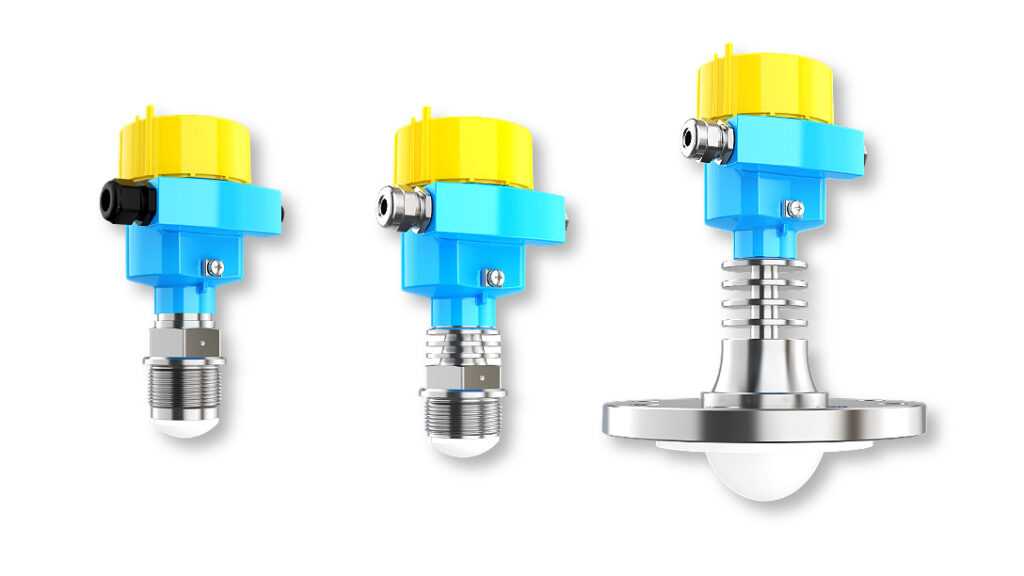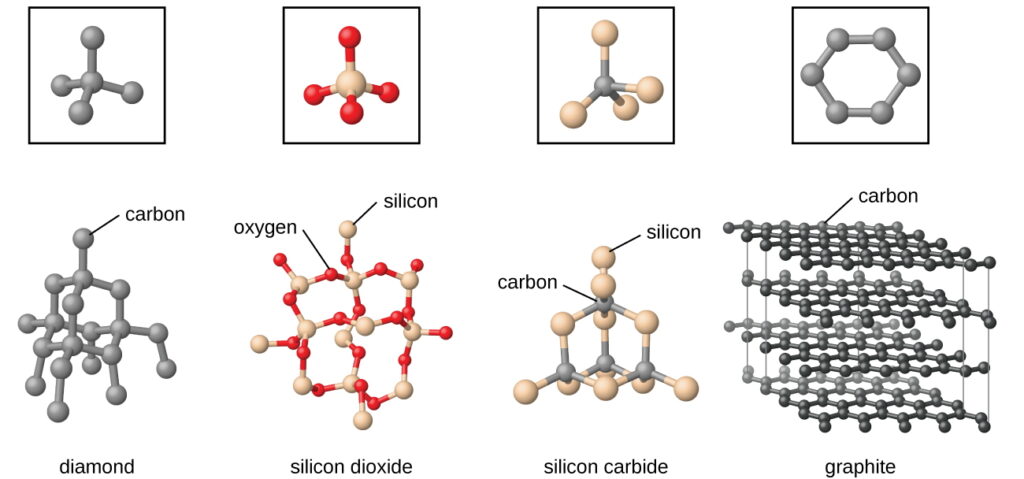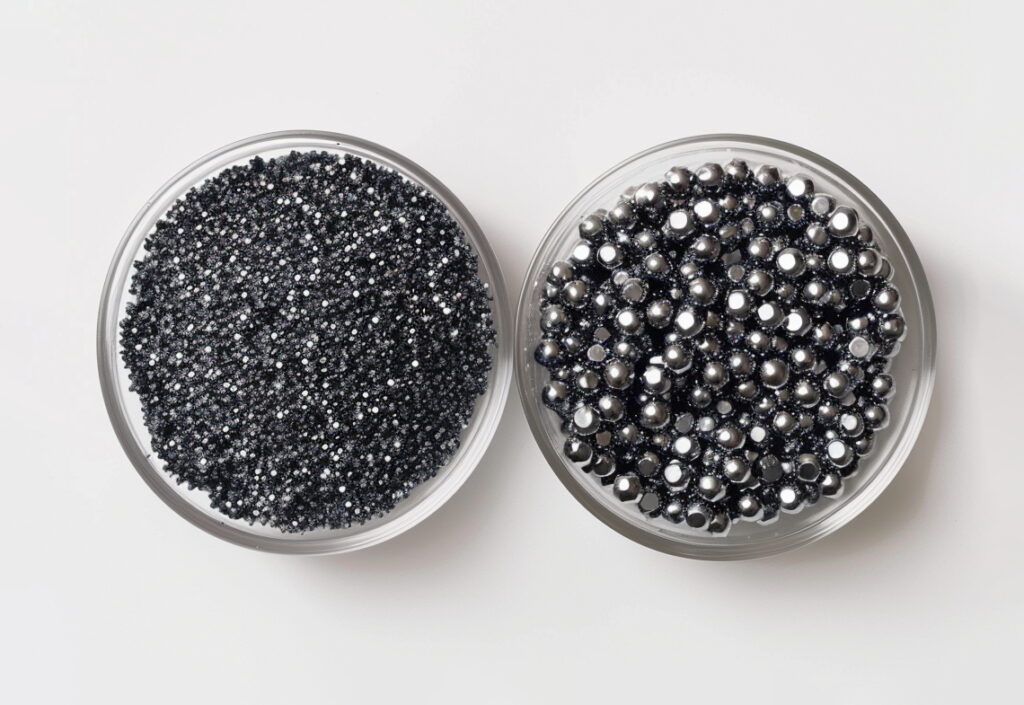Dielectric Constants List——A Guide to Choosing Radar Level Transmitters
Radar Level Transmitter Selection: Start with the “Type of Medium”
Dielectric constants (εr) is one of the most fundamental factors in the selection of a radar level transmitter. The type of medium—whether liquid, solid, slurry, foam, or volatile fluid—greatly affects its dielectric constant. These variations significantly influence the strength of the reflected radar signal, the transmitter’s ability to recognize the echo, and ultimately the accuracy and reliability of the level measurement.

Why Is the Dielectric Constant So Important?
Radar level transmitters operate based on the principle of electromagnetic wave reflection:
The radar emits electromagnetic waves from the antenna, which are reflected upon reaching the surface of the medium. The transmitter calculates the distance based on the time delay of the signal’s return.

The strength of this reflection depends heavily on the dielectric constant of the material:
- High Dielectric Constant (>10): Strong reflection, clear signal, easy to measure
Examples: Water, sulfuric acid, ethanol, nitrobenzene - Medium Dielectric Constant (3–10): Measurable, but requires optimized antenna design or higher radar frequency
Examples: Diesel, tar, certain powders - Low Dielectric Constant (<3): Weak reflection, requires high-sensitivity radar (e.g., 80 GHz or horn-type antenna)
Examples: Plastic pellets, polypropylene powder, foaming liquids, light hydrocarbons

Why a Dielectric Constant Reference Table Matters
Knowing the exact dielectric constant of the target medium is essential for proper selection. The following comprehensive reference table includes dielectric constants of hundreds of commonly encountered industrial substances (liquids, gases, powders, granules, etc.). Engineers can consult this during specification to avoid poor or failed measurements caused by improper transmitter selection.
Application Examples:
| Medium | Dielectric Constant εr | Recommended Radar Frequency | Notes |
|---|---|---|---|
| Ethanol | 16.2 | 26 GHz, 80 GHz | Volatile; sealed measurement recommended |
| Fly ash | 1.8–2.5 | 80 GHz, horn antenna | Weak reflection; mind installation angle |
| Benzene | 2.3 | 80 GHz or high-sensitivity | Susceptible to vapor interference |
| Molasses | 31.3 | Any | Strong signal; easy to measure |
Conclusion: The Dielectric Constant Table Is an Essential Tool for Radar Level Transmitter Selection
The type of medium ultimately determines measurement success. Materials with different dielectric constants reflect radar signals in vastly different ways. Selecting the wrong frequency or antenna design can lead to weak echo signals, unstable measurements, or complete signal loss.
Therefore, building a systematic, searchable dielectric constant database is vital for engineers involved in instrumentation and process control. To address this, we have compiled a comprehensive dielectric constant reference table featuring nearly 1,000 substances—including liquids, gases, slurries, powders, granules, food ingredients, and chemical raw materials. The table not only lists the dielectric constants but also indicates radar compatibility and recommended frequency bands, offering high-value guidance for product selection.
📘 Click to Access: Complete Dielectric Constant Reference Table for Common Materials
| Substance | Dielectric Constant |
| A | |
| Acetal | 3.8 |
| Acetaldehyde | 15.0 |
| Acetamide (77°C) | 59.2 |
| Acetic acid | 6.2 |
| Acetoacetic acid ethyl ester | 15.0 |
| Acetone | 21.5 |
| Acetophenone | 18.0 |
| Acetyl bromide | 16.2 |
| Acetyl chloride | 15.9 |
| Acetylacetone | 23.0 |
| Acetylene dibromide | 7.2 |
| Acetylene tetrabromide | 5.6 |
| Aconite acid ester | 6.3 |
| Activated carbon | 12.0 |
| Adipic Acid | 1.8 |
| Aerosile | 1.0 |
| Aether | 4.0 |
| Allyl alcohol | 20.6 |
| Allyl chloride | 8.2 |
| Allyl iodide | 6.1 |
| Alum (60°C) | 4.2 |
| Aluminium bromide (100°C) | 3.4 |
| Aluminium foil | 10.8 |
| Aluminium hydroxide | 2.5 |
| Aluminium splinters | 7.3 |
| Aluminium sulfate | 2.6 |
| Ammonia | 15.0 |
| Ammonia salt | 4.3 |
| Ammonia solution (25%) | 31.6 |
| Amyl amine | 4.5 |
| Aniline | 7.0 |
| Animal feed grist | 2.4 |
| Anisealdehyde | 22.3 |
| Anisole | 4.5 |
| Anthracite/hard coal | 3.2 |
| Antimony hydride | 1.8 |
| Argon | 1.5 |
| Arsine | 2.1 |
| Arsole | 2.3 |
| Asbestos | 10.0 |
| Ascorbic acid | 2.1 |
| Azelaic acid diethylester | 5.0 |
| Azoxybenzene (36°C) | 5.2 |
| B | |
| Basalt | 2.5 |
| Bauxite | 2.5 |
| Beer brew | 25.0 |
| Beets cuttings | 7.3 |
| Beets seeds | 3.5 |
| Bentonite | 8.1 |
| Benzal chloride | 6.9 |
| Benzaldehyde | 17.6 |
| Benzene | 2.3 |
| Benzene, heavy | 3.2 |
| Benzil (80°C) | 10.0 |
| Benzine | 2.0 |
| Benzyl alcohol | 13.5 |
| Benzyl chloride | 7.0 |
| Benzylamine | 4.6 |
| Bitumen | 2.8 |
| Black liquor | 32.0 |
| Bone fat | 2.7 |
| Bonemeal | 1.7 |
| Bore oil emulsion | 25.0 |
| Bornylacetate | 4.6 |
| Bromine | 3.1 |
| Butanoic acid | 3.0 |
| C | |
| Cacao beans | 1.8 |
| Calcium fluoride | 2.5 |
| Camphene | 2.3 |
| Caproic acid (71°C) | 2.6 |
| Caprylic acid | 2.5 |
| Carbazole | 1.3 |
| Carbon black | 18.8 |
| Carbon disulfide | 2.6 |
| Carbon tetrachloride | 2.3 |
| Carbonylcyanid | 10.7 |
| Caustic potash | 3.3 |
| Cellit | 1.6 |
| Cellulose | 1.2 |
| Cement | 2.2 |
| Cement asbestos | 3.2 |
| Ceramic compound | 17.0 |
| Cetyl alcohol (60°C) | 3.6 |
| Chaff | 1.5 |
| Chalk | 2.1 |
| Chamotte | 1.8 |
| Charcoal | 1.3 |
| Chloorhydrin | 31.0 |
| Chlorobenzene | 5.7 |
| Chlor, fluid | 2.1 |
| Chloral | 6.7 |
| Chlorinated lime | 2.3 |
| Chloroacetic acid | 33.4 |
| Chloroform | 4.8 |
| Chocolate powder | 2.0 |
| Clay | 2.3 |
| Coal dust | 2.5 |
| Coal (15% moisture) | 4.0 |
| Coconut oil (refined) | 2.9 |
| Coffee beans | 1.5 |
| Coke | 3.0 |
| Cola essence | 17.3 |
| Concentrated feed | 3.2 |
| Copper ore | 5.6 |
| Cork powder | 1.7 |
| Corn | 3.6 |
| Corn grist | 2.1 |
| Corn starch syrup | 18.4 |
| Cotton fibre flour | 3.2 |
| Cream (skin) | 19.0 |
| Cresol | 11.0 |
| Cresol resin | 18.3 |
| Crystal sugar | 2.0 |
| Cullet (glass shards) | 2.0 |
| Cuminaldehyde | 10.7 |
| Cyanogen | 2.5 |
| D | |
| Decalin | 2.1 |
| Degalan | 3.1 |
| Desmodur | 10.0 |
| Diacetone alcohol | 18.2 |
| Diamylether | 3.0 |
| Diatomaceous earth | 1.4 |
| Dibenzofuran (100°C) | 3.0 |
| Dibenzyl (60°C) | 2.5 |
| Diesel fuel | 2.1 |
| Diethyl carbonate | 2.8 |
| Diethylamine | 3.8 |
| Dimethyl ether | 5.0 |
| Diofan | 32.0 |
| Dioxane | 2.0 |
| Diphenyl (75°C) | 2.5 |
| Dry yeast | 2.0 |
| E | |
| Emulphor | 4.0 |
| Epichlorhydrin | 23.0 |
| Ethanol (ethyl alcohol) | 16.2 |
| Ethyl acetate | 6.0 |
| Ethyl benzene | 2.4 |
| Ethyl benzoate | 6.0 |
| Ethyl mercaptan | 6.9 |
| Ethylamine | 6.9 |
| Ethylene chlorhydrin | 25.0 |
| Ethylene chloride | 10.6 |
| Ethylenediamine | 15.0 |
| Ethylene oxide (-1°C) | 13.9 |
| F | |
| Fat coal | 3.4 |
| Fatty acid (35°C) | 1.7 |
| Fenchone | 12.8 |
| Ferrite pellets | 21.0 |
| Ferrosilicon | 10.0 |
| Ferrozell | 18.3 |
| Fertiliser | 4.3 |
| Fiber glass powder | 1.0 |
| G | |
| Glycol | 37.0 |
| Glysantin | 25.0 |
| Grain grist | 3.0 |
| Grain of mustard | 3.6 |
| Grain of soy | 2.9 |
| Granuform | 4.0 |
| Gravel | 2.6 |
| Green vitriol | 32.4 |
| Guaiacol | 11.0 |
| Guano | 2.5 |
| Gypsum | 1.8 |
| H | |
| Hazels | 2.0 |
| Heating oil | 2.1 |
| Heavy fuel oil | 2.2 |
| Helium | 1.1 |
| Heptanal | 9.1 |
| Heptane | 1.9 |
| Heptanoic acid (71°C) | 2.6 |
| Heptene | 2.1 |
| Hexachlorobutadiene | 2.6 |
| Hexane | 1.9 |
| Hexanol | 12.5 |
| Hexene | 2.1 |
| Hibiscus | 2.8 |
| Honey | 24.0 |
| Hot glue (150°C) | 2.3 |
| Hydrazine | 58.0 |
| Hydrochloric acid | 5.0 |
| Hydrogen | 1.2 |
| Hydrogen cyanide | 158.0 |
| Hydrogen fluoride (0°C) | 83.6 |
| Hydrogen iodide | 2.9 |
| Hydrogen peroxide (0°C) | 84.2 |
| Hydrogen sulfide | 6.0 |
| I | |
| Ice cream (-20°C) | 16.5 |
| Imidazole (100°C) | 23.0 |
| Iodine | 11.1 |
| Iodobenzene | 4.6 |
| Iron(III) oxide red | 1.9 |
| Isoamyl acetate | 4.8 |
| Isoamyl alcohol | 15.6 |
| Isoamyl bromide | 6.0 |
| Isoamyl chloride | 6.1 |
| Isoamyl ether | 2.8 |
| Isoamyl iodide | 5.6 |
| Isobutanoic acid | 2.6 |
| Isobutyl alcohol | 18.1 |
| Isobutyl amine | 4.4 |
| Isobutyl benzene | 2.3 |
| Isobutyl bromide | 7.2 |
| Isobutyl chloride | 6.5 |
| Isobutyl cyanide | 18.0 |
| Isobutyl iodide | 6.5 |
| Isobutyl nitrate | 11.7 |
| Isobutyl silane | 2.5 |
| Isocyanate | 6.1 |
| Isoprene | 2.1 |
| Isopropanol | 18.0 |
| Isoquinoline | 10.7 |
| Isosafrol | 3.3 |
| K | |
| Ketchup | 24.0 |
| L | |
| Lanolin | 4.2 |
| Lard (80°C) | 2.1 |
| Latex | 24.0 |
| Lauric acid ethyl ester | 3.4 |
| Lime | 2.0 |
| Linoleic acid | 2.7 |
| M | |
| Malic acid diethylester | 10.0 |
| Malt | 2.7 |
| Mandelic acid nitrile | 18.0 |
| Marble stones small (2-3 mm) | 2.5 |
| Meat and bone meal | 1.9 |
| Meat and bone meal (alternative) | 2.2 |
| Menthol (42°C) | 4.0 |
| Mercury diethyl | 2.1 |
| Mesityl oxide | 15.0 |
| Metal powder | 6.0 |
| Methanol (methyl alcohol) | 33.0 |
| Methyl acetate | 8.0 |
| Methyl cellulose | 3.0 |
| Methyl iodide | 7.1 |
| Methyl nitrate | 23.5 |
| Methylene bromide | 7.0 |
| Methylene chloride | 9.0 – 9.1 |
| Methylene iodide | 5.3 |
| Mice feed | 2.3 |
| Molasses | 31.3 |
| Mono chlormethane | 9.8 |
| Morpholine | 7.3 |
| Mustard | 24.0 |
| N | |
| Naphtalene | 2.5 |
| Naphthenic acid | 2.6 |
| Nitric acid (98%) | 19.0 |
| Nitro phoska | 5.4 |
| Nitro varnish | 5.2 |
| Nitrobenzene | 35.0 |
| Nitroethane | 29.0 |
| Nitroglycerin | 19.3 |
| Nitroglycol | 28.3 |
| Nitromethane | 39.0 |
| Nitrosyl bromide | 15.2 |
| Nitrosyl chloride | 19.0 |
| O | |
| Oat | 4.9 |
| Octane | 2.0 |
| Octene | 2.1 |
| Octyl bromide | 5.0 |
| Oil | 2.0 |
| Oleic acid | 2.5 |
| R | |
| Rapeseed grist | 2.1 |
| Resin | 1.5 |
| Rice | 3.0 |
| Rock salt (0-25 mm) | 4.3 |
| Rye | 6.0 |
| Rye bran | 2.2 |
| S | |
| Saccharose solution | 20.0 |
| Salt water | 32.0 |
| Sawdust | 1.3 |
| Silica sand | 2.0 |
| Silicic acid | 2.0 |
| Silicone oil | 2.7 |
| Silicone rubber | 2.9 |
| Skim milk powder | 2.3 |
| Soap flakes | 9.2 |
| Soap pellets | 3.5 |
| Soda | 3.0 |
| Sodium chloride | 23.0 |
| Sodium methylate | 1.5 |
| Sodium perborate | 2.2 |
| Sodium peroxide | 2.7 |
| Sodium silicate | 16.0 |
| Sodium sulfate | 2.7 |
| Soft soap | 32.0 |
| Solvent | 18.0 |
| Soy flour | 4.5 |
| Splints | 1.1 |
| Stearic acid | 2.3 |
| Styrene | 2.4 |
| Sugar | 1.8 |
| Sulfur trioxide | 3.1 |
| Sulfuric acid | 21.9 |
| Sulfuric acid (17%) | 31.0 |
| Sulfuric acid (97%) | 8.6 |
| Sulphur | 3.5 |
| Sulphur dioxide | 14.0 |
| Sunflower seeds | 2.0 |
| T | |
| Talcum | 1.5 |
| Tankage | 1.9 |
| Tar | 4.0 |
| Tartaric acid | 35.9 |
| Tea powder | 2.0 |
| Terephthalic acid | 1.5 |
| Terpinene | 2.7 |
| Terpinolene | 2.3 |
| Tetrachlorethylene | 2.5 |
| Thomaskali dust | 3.4 |
| Thujone (0°C) | 10.8 |
| Tinder | 12.0 |
| Titan tetrachloride | 2.8 |
| Tobacco dust | 1.8 |
| Toluene | 2.4 |
| Tooth paste | 18.3 |
| Transformer oil | 2.1 |
| Trichloroethylene | 3.2 |
| Triethylaluminium | 2.9 |
| Triptan | 1.9 |
| U | |
| Ultrasil | 1.4 |
| Undecan | 2.0 |
| Urea | 2.9 |
| V | |
| Valeric acid | 2.7 |
| Vinegar | 24.0 |
| Viscose | 34.5 |
| W | |
| Water | 80.3 |
| Water (360°C) | 10.0 |
| Water, demineralized | 29.3 |
| Water, heavy | 78.3 |
| Water-in-oil emulsion | 24.2 |
| Wax | 1.8 |
| Wheat | 4.0 |
| Wheat starch | 2.5 |
| White spirit | 2.0 |
| Wine | 25.0 |
| Wood chips | 2.3 |
| Wood swarf | 1.5 |
| X | |
| Xylene | 2.3 |
| Xylitol | 40.0 |
| Z | |
| Zinc oxide | 1.5 |
| Zinc powder | 4.4 |
